
Abstract Archives of the RSNA, 2007
Bo Qiang MS, Abstract Co-Author: Nothing to Disclose
Jun Ni PhD, Presenter: Nothing to Disclose
Laurie Lee Fajardo MD, Abstract Co-Author: Board of Directors, Hologic, Inc
The purpose of this research is to develop a parallel implementation of the Monte Carlo simulation of diffuse optical tomography (DOT) in biological heterogeneous tissues.
Light in certain wavelength ranges can penetrate deep into biological tissues. A near-Infrared (NIR) light with a wavelength within a range from 600 nm to 1000 nm can go through human epidermis layers and interact with organs such as blood vessels, fat cells, muscles and neurons. This phenomenon inspires the development of a Diffuse Optical Tomography (DOT)-based, non-invasive diagnostic measurement. Combined with CT and/or MRI, DOT provides a higher selectivity and sensitivity for early-stage breast cancer detection than the mammogram. Its advantages and high clinical demands encourage us to develop an efficient simulation of multi-photon migration. Monte Carlo simulation, as one of promising numerical methods, tracks photons’ movements within heterogeneous tissues through a stochastic description. However, it requires a much computing time.
The parallel Monte Carlo simulation is developed and implemented using a task-decomposition algorithm. The movement of each single photon inside a biological tissue follows a random journey. This can be simulated on a single computing process. Using a multi-processor cluster, the whole multi-photons can be simulated in parallel.
We parallelize the Monte Carlo simulation using C programming language with the message passing library (MPI). The parallelism of 10000 photon walks is conducted and performed on an HPC cluster with 96 processors of 3.4GHz, and a 10Gbit InfiniBand interconnection. Each processor is responsible for 200 photons. The computation is of high performance in terms of linear speedup and high efficiency with an excellent scalability.
The parallel Monte Carlo simulation for photon diffuse optical tomography is a very promising computational method. It can be used to handle future large-scale photon migration.
The parallel computing for optical image tomography provides insight into future research and clinical use of DOT-based non-invasive diagnostic systems.
Qiang, B,
Ni, J,
Fajardo, L,
Parallel Monte Carlo Algorithm for Simulation of Photon Migration inside Biological Tissues. Radiological Society of North America 2007 Scientific Assembly and Annual Meeting, November 25 - November 30, 2007 ,Chicago IL.
http://archive.rsna.org/2007/5012242.html

